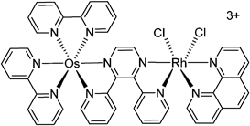Scientists in the US have developed a new photodynamic therapeutic reagent that works in the absence of oxygen.
Photodynamic therapy (PDT) is an emerging treatment used to eradicate premalignant and early-stage cancer, and also reduces tumour size in end-stage cancers. PDT works by exposing the tissue sample to a light source, which excites the PDT reagent causing singlet oxygen to form due to a reaction with the more common triplet oxygen. The resulting singlet oxygen then invokes cell death in tumour cells.

The PDT reagent has been designed by Karen Brewer and co-workers from Virginia Tech, where they have shown its capabilities for binding and photocleaving DNA under red light irradiation. The anti-cancer complex [(bpy)2Os(dpp)RhCl)2(phen)]3+ has two metal centres; the osmium portion is capable of photocleaving DNA by singlet oxygen generation and the rhodium part is capable of binding to the DNA in the first place.
Crucially, this is the first complex that works in the absence of oxygen. Tumour cells are often oxygen-depleted environments and therefore a treatment that functions in the absence of oxygen is an important step forward. Future investigations will centre on the bioreactivity of this and other related complexes.
Interested in finding out more? Then download the ChemComm article, which will be free to access until 25th July 2011.










